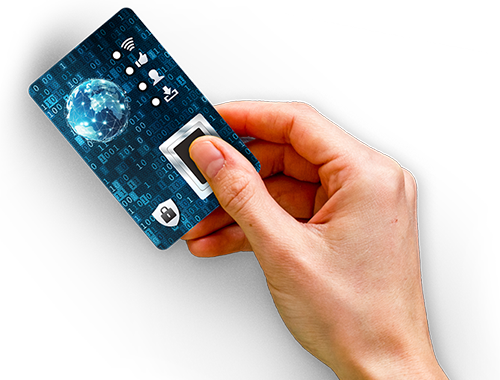- Biometric System-on-Card
- Security Sensitive Markets Requirements
- APPSCARD Approach
- Summary
- Frequently asked questions
Designed from the ground up for uncompromised security across all card functions and usage contexts.
Biometric System-on-Card
A Biometric System-on-Card (BSoC) integrates fingerprint sensing, processing, biometric comparison and secure data storage within a single smartcard. When properly implemented, it fundamentally enhances security, privacy, and usability by ensuring that personal data never leaves the card and the user interacts only with their own device.
Most biometric cards today are built for payments, prioritizing low cost and fast response over biometric reliability. Enrollment is often unsupervised, and a PIN is retained as fallback — unacceptable for governmental or high-security use.
Security Sensitive Market Requirements
For such environments, the following requirements are mandatory:
- Coverage of nearly the entire user population
- Supervised enrollment by trained officers
- High biometric performance with minimal false rejects
- No insecure fallback methods
- Compliance with standardized data formats and certified algorithms
APPSCARD Approach
APPSCARD has developed a “Government-Grade Biometric Computer in a Card” — a multifunctional platform that authenticates users, performs cryptographic operations, and stores far more data than a standard smartcard.
Sensor
At its core lies a government-grade fingerprint sensor compliant with ISO/IEC 17389-2 Class D, featuring a 210 mm² active area at 500 ppi. Combined with a certified algorithm, it provides superior real-world performance and tolerance to finger placement, quality, and environmental variations.
MCU
Processing high-resolution images (> 90k pixels) demands a powerful microcontroller unit (MCU) that performs image processing and minutiae extraction. The biometric reference is sent via an encrypted channel to the secure element (SE) for storage and comparison.
Secure Element
The SE, certified at EAL 6+, runs a custom JavaCard OS supporting GlobalPlatform applet management and optionally controls encrypted mass storage. Customers can load applications for authentication, digital signature, or secure data transport.
Energy Management
The BSoC operates contactless using the terminal’s RF field. APPSCARD’s optimized energy management enables reliable operation even with sub-standard readers, fulfilling its goal to open “all doors” across legacy infrastructures.
Housing and Tamper Protection
Built in the ID-T form factor (ISO/IEC 18328-2), the 2.25 mm-thin card fits standard wallets yet houses reinforced materials and conformal coatings that destroy internal circuits upon tampering, ensuring lifetime integrity.
Summary
Unlike convenience-oriented payment cards, the APPSCARD BSoC delivers government-grade security, multifunctionality, and real-life robustness — fully compliant with international standards and ready for both digital and physical access ecosystems.





